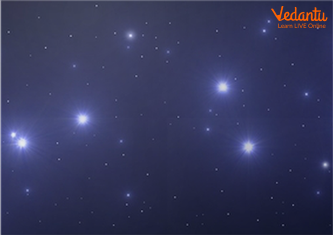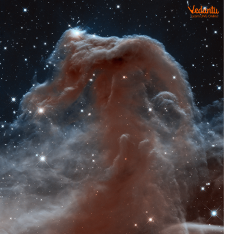




What Are the Stages in a Star’s Life?
Giant spheres of superheated gas, primarily hydrogen and helium, make up stars. Some chemical reactions cause these gases, hydrogen to convert or change into helium, which is how stars become very hot. It is because of this that stars appear bright and dazzling. Do you know that the Sun is also a star? To learn more about these twinkling lights or stars in the sky, continue reading through the following.
Lifecycle of a Star
Birth – Nebulae, or huge clouds of dust, are the birthplace of stars. The dust is pushed together by gravity. As more material clumps together, gravity becomes stronger, and the star begins to heat up and become a protostar. Nuclear fusion, a type of chemical reaction, will begin once the centre is hot enough, and a young star will be born.

A Cluster of Stars – Pleiades
Main Sequence Star
These types of stars will continue to burn energy and glow for billions of years after they cease to be a star. The "main sequence" describes the state of the star over the majority of its life. During this time, a balance is struck between gravity's desire to reduce the star and heat's desire to expand it. This is how the star will stay until it runs out of hydrogen.
Red Giant
When the hydrogen in the star runs out, the star expands and turns into a red giant.
Collapse
The star's core will eventually begin to produce iron. This will result in the star collapsing. What happens next to the star is determined by its mass (how big it was). The ordinary star will fade into obscurity and become a white dwarf. Larger stars will produce a supernova, which is a massive nuclear explosion. It could become a black hole or a neutron star after the supernova.
Stars form from the massive clouds of dust, known as nebulae. It is represented below.

The Horsehead Nebula
Types of Stars
Stars appear in a variety of shapes and sizes. The colour of stars in their main sequence (normal stars) is used to classify them. The smallest stars are red and emit very little light. Like the Sun, medium-sized stars are yellow. The brightest stars are blue and extremely massive. The hotter and brighter a main sequence star is, the larger it is.
Dwarfs
Dwarf stars are stars that are smaller than the Sun. Dwarfs are stars that are red or yellow in colour. A brown dwarf is a star that never grew large enough to undergo nuclear fusion. A white dwarf is the remains of a red giant star that has collapsed.
Giants
Giant stars can be main sequence stars, such as blue giants, or expanding stars, such as red giants. Some supergiant stars are so massive that they eclipse the entire Solar System!
Neutrons
The collapse of a giant star produces a neutron star. It's small, but it's dense.
Fun Facts about Stars
Red dwarfs make up the majority of the stars in the universe.
The movement of the Earth's atmosphere causes them to sparkle.
Many stars are found in pairs, known as binary stars. Some groupings have as many as four stars.
They live longer if they are smaller. Giant stars shine brightly, but they burn out quickly.
Proxima Centauri is the closest star to Earth. It's 4.2 light-years away, which means it'd take 4.2 years to travel at the speed of light to get there.
The age of the Sun is estimated to be roughly 4.5 billion years.
Conclusion
We hope you have learnt something new about the stars and the Sun in the sky today through this article. The world we live in is full of such mysterious and exciting things and occurings and there is no end to learning about them. If you found this article insightful and wish to read more of such similar topics, head over to our website and discover from the plethora of articles on interesting topics for kids.
FAQs on Stars and Their Lifecycle: A Simple Guide for Students
1. What is a star and what is it made of?
A star is a giant, glowing ball of very hot gas in space. Most stars, including our Sun, are made mainly of two gases: hydrogen and helium. They are held together by their own gravity, which is what gives them their round shape.
2. What makes the stars shine so brightly?
Stars shine because of a powerful process happening in their core called nuclear fusion. The immense pressure and heat at the centre of a star squeeze hydrogen atoms together to form helium. This process releases a massive amount of energy in the form of light and heat, which travels through space and reaches our eyes, making the star appear to shine.
3. What is the life cycle of a star, explained simply?
A star's life cycle is its journey from birth to death, which takes billions of years. It generally follows these stages:
- Birth: Stars are born in huge clouds of gas and dust called nebulas.
- Main Sequence: For most of its life, a star is a stable 'main-sequence star' (like our Sun), fusing hydrogen into helium.
- Old Age: As it runs out of fuel, it swells up to become a red giant.
- Death: What happens next depends on its size. A smaller star shrinks into a white dwarf, while a massive star explodes in a supernova, leaving behind a neutron star or a black hole.
4. How are new stars born from a nebula?
New stars are born inside vast, cold clouds of gas and dust known as nebulas. Gravity pulls clumps of this gas and dust together. As a clump gets denser, it starts to spin and heat up, forming a protostar. When the core of the protostar becomes hot and dense enough, nuclear fusion begins, and it ignites to become a shining new star.
5. How are stars different from each other?
Stars are not all the same; they vary in several ways. The main differences are their size, temperature, colour, and brightness. Some stars are massive giants, hundreds of times bigger than our Sun, while others are tiny dwarfs. Their temperature determines their colour—the hottest stars are blue, while the coolest stars are red.
6. Why do stars have different colours, like red, yellow, and blue?
A star's colour is a direct clue to its surface temperature. Just like a piece of metal glows red when it's hot and turns white-hot or blue-hot when it gets even hotter, stars do the same. Blue stars are the hottest, white and yellow stars (like our Sun) are in the middle, and red stars are the coolest.
7. How is our Sun different from other stars we see at night?
Our Sun is a star, just like the ones we see at night. The main difference is its distance from Earth. The Sun is the closest star to us, which is why it looks like a giant, bright disc that provides us with light and warmth. The other stars are incredibly far away, so they appear as tiny points of light in the night sky, even though many of them are much larger and brighter than our Sun.
8. Why do stars appear to twinkle in the night sky?
Stars appear to twinkle because their light has to travel through Earth's atmosphere before it reaches our eyes. The atmosphere has many layers of moving air at different temperatures. As the starlight passes through these turbulent layers, it gets bent and distorted, causing the star to look like it's sparkling or twinkling.
9. What is a constellation?
A constellation is a group of stars that form a recognisable pattern or picture in the night sky. For centuries, people have connected the dots between stars to imagine figures of animals, mythological heroes, or objects. Some famous examples include Orion (the Hunter) and Ursa Major (the Great Bear), which helps us locate the Pole Star.
10. What happens when a very big star dies?
When a massive star, one much larger than our Sun, runs out of fuel, it doesn't fade away quietly. It collapses and then explodes in a spectacular event called a supernova. A supernova is one of the most powerful explosions in the universe. After the explosion, the star's core might be crushed into an incredibly dense object called a neutron star or, if the star was massive enough, a black hole.
11. Are all the stars we see in the sky still there?
Because stars are so far away, their light takes a very long time to reach us—a concept called light years. For some distant stars, the light we see tonight left that star thousands or even millions of years ago. This means it's possible that some stars we see have already died, perhaps in a supernova, but their 'last light' is still travelling through space and hasn't reached us yet.





















